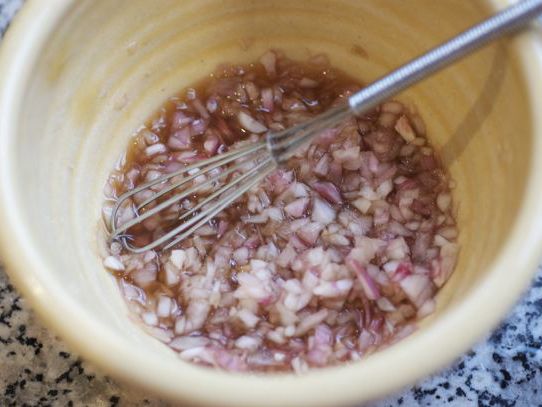
reference-image, l
(post, Anne Zimmerman)
The other day, my boyfriend and I were discussing the culinary skills of a mutual friend. “She doesn’t cook very much,” I said. “She doesn’t have the time.” “But she’s good,” he replied. “Did you taste that vinaigrette?” My heart fluttered a bit. Did he judge someone’s culinary wisdom and capability by the strength of her vinaigrette? If so, I was totally screwed. I grew up hating salad. It was something about the texture, the crunch of the lettuce, the cold, wet leaves. It didn’t help that most of the salads I encountered were composed of iceberg lettuce, shredded carrots, and Hidden Valley Ranch dressing. I hated these salads, and it became much easier to employ an all-out ban on the green stuff than to deal with what might show up on the salad plate. [[block(sidebar). h1.Featured recipe]] Then I grew up and learned to like salad. Sort of. I still don’t often make it for myself. I love salads that are put down on a pretty plate in front of me, salads that someone else has thought about, carefully created, and gently dressed. There’s something about actually making a salad that scares me. It seems so simple, but is it? Do you tear the lettuce leaves, chop them, or leave them whole? Should it be basic (just greens) or more complex — sliced tomatoes or cucumbers, cheeses, onions, nuts? And then there is the issue of the vinaigrette. I have never made a vinaigrette I liked. Apparently, this could be a bigger problem than I realized. So I set out to discover my signature salad dressing: a vinaigrette I could make in a pinch, without worry, and that wasn’t too oily, acidic, or lackluster. [%image reference-image float=left width=400 caption="The basis of her beautiful vinaigrette."] First I did my research. I learned that basic vinaigrette is traditionally one part acid to three parts oil. Mark Bittman, of How to Cook Everything (Completely Revised 10th Anniversary Edition) fame, doesn’t recommend using strong vinegars such as red wine or balsamic in vinaigrettes because they are overpowering. Perhaps this was my problem? I had dressed many a bed of greens with an unmeasured mix of balsamic and olive oil and never enjoyed the results. I decided to try a vinaigrette of white-wine vinegar, chopped shallots, olive oil, Dijon mustard, salt, and pepper. It was good. In fact, it was good enough that I ate an entire salad without ever once feeling as if I would need to force myself to finish. So maybe I was getting somewhere. But part of me wanted my vinaigrette to be stronger and have more of a bite. More like my boyfriend’s vinaigrette, in fact. So how did he do it? His recipe was simple too. He takes one minced shallot and a pinch of salt. He puts this in a small bowl and covers it with sherry vinegar, and lets it sit for at least 30 minutes (this neutralizes the oniony part of the shallot, he says). Then he adds one small teaspoon of whole-grain mustard and maybe a pinch of thyme. Next he whisks in the olive oil until the vinaigrette is the right texture, then tastes and adjusts, adding more vinegar if needed or salt and pepper. I made this vinaigrette, and with the first bite I realized that this was the recipe I loved. The savory, piquant dressing tastes just right to me and my palate. So much for Mark Bittman’s theory of no strong vinegars. But there were other quandaries too. What about other additions to a good vinaigrette — the squeezes of lemon or orange juice or the pinch of honey or brown sugar? What about fresh herbs or rice-wine vinegar? What is a vinaigrette virgin to do? I have to admit that my research stopped there — not because I was overwhelmed, but because I was content. I love my boyfriend’s "secret" recipe and am happy to add it to my arsenal. I’ve been buying bags of greens at the market and eating salads almost every day. I make small jars of vinaigrette with strong, acidic sherry vinegar and tiny pieces of purple minced shallot. It tastes good, it’s easy, and above all, it makes me want to eat my vegetables.

reference-image, l